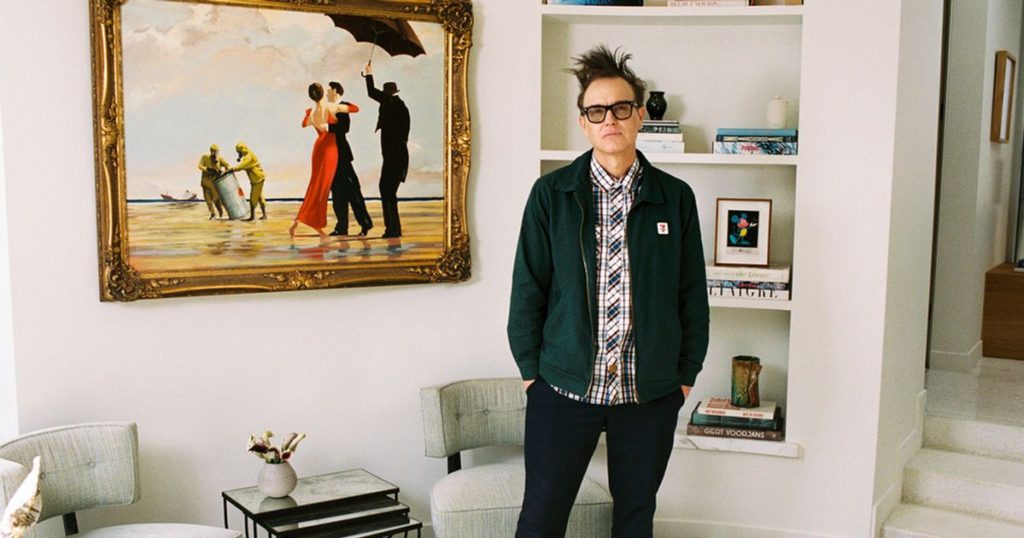Banksy’s Environmental Statement Hits the Auction Block: "Crude Oil (Vettriano)"
A powerful piece by the elusive street artist Banksy, titled “Crude Oil (Vettriano)”, is set to go under the hammer at Sotheby’s auction house in London next month. This painting, which carries a strong environmental message, is expected to fetch up to 5 million pounds ($6.3 million). What makes this auction even more significant is that a portion of the proceeds will be donated to support victims of the devastating Los Angeles wildfires, as well as other charitable causes. The artwork, part of Banksy’s 2005 series, is a satirical reimagining of Jack Vettriano’s “The Singing Butler”, with Banksy’s signature twist.
The seller of this piece is none other than Mark Hoppus, the bassist of the iconic California skate-punk band Blink-182. Hoppus, who has long admired Banksy’s work, purchased the painting in 2011 with his wife, Skye Everly. He has described the artwork as “unmistakably Banksy, but different,” and has displayed it in his homes in London and Los Angeles over the years. Hoppus, who sees Banksy as a kindred spirit, has always been drawn to the subversion, humor, and intelligence in the artist’s work. He also finds a deep connection between Banksy’s art and the ethos of skateboarding and punk rock—both of which thrive on rebellion, creativity, and a DIY spirit.
Banksy’s Satirical Masterpiece: A Commentary on Environmental Destruction
“Crude Oil (Vettriano)” is one of several works Banksy created in 2005, where he took iconic paintings and gave them a satirical, contemporary twist. In this piece, he transforms Vettriano’s romantic scene of a couple dancing on a beach into a stark commentary on environmental destruction. The original painting, “The Singing Butler”, features a couple in evening attire, surrounded by servants holding umbrellas, exuding a sense of elegance and escapism. Banksy’s version, however, adds a sinking oil liner in the background and two figures dragging a barrel of toxic waste, starkly contrasting the idyllic scene with the harsh realities of industrial pollution.
Banksy’s aim with this series was to highlight the hypocrisy of societal norms that often blame individuals—such as graffiti artists and teenagers—for environmental damage, while ignoring the far greater impact of corporate practices. By taking familiar, beloved artworks and altering them to reflect modern issues, Banksy forces viewers to confront uncomfortable truths about the world we live in. His distinct style, which combines wit, rebellion, and social commentary, has made him one of the most recognizable and celebrated artists of our time.
Mark Hoppus: A Shared Spirit of Rebellion and Creativity
Mark Hoppus, who is parting with this painting after a decade, has expressed his deep admiration for Banksy’s work. He sees a shared spirit between Banksy’s art and the punk rock and skateboarding cultures that have shaped his own life and career. Both, he believes, are about embracing rebellion, rejecting mainstream norms, and creating something meaningful from the margins. Hoppus has said, “The left-out and overlooked making their own reality… Just go make art. It’s the same spirit. And I’ve loved art and especially street art ever since realizing that.”
This shared ethos is part of what drew Hoppus to “Crude Oil (Vettriano)”. The painting’s blend of satire, intelligence, and a refusal to conform resonates deeply with his own approach to music and art. While parting with the piece is no doubt bittersweet, Hoppus plans to use the proceeds from the sale to support emerging artists and donate to several charitable causes, including the California Fire Foundation, Children’s Hospital Los Angeles, and Cedars Sinai Hematology Oncology Research.
Banksy’s Legacy: From Bristol Streets to Global Icon
Banksy’s journey from a street artist in Bristol, England, to a global phenomenon is nothing short of remarkable. Known for his mischievous and often satirical works, he has become a household name without ever revealing his full identity. His art has included iconic pieces like “Love is in the Bin”—a partially self-destructed image of a girl with a balloon that sold for nearly 18.6 million pounds ($25.4 million)—and “Laugh Now, But One Day I’ll Be in Charge”, featuring a chimpanzee holding a sign with a chillingly prophetic message.
Banksy’s ability to merge art with activism has made him a powerful voice for social and environmental causes. His works often challenge the status quo, urging viewers to think critically about the world around them. Whether it’s the destruction of the environment, the inequalities of capitalism, or the failings of authority, Banksy’s art has become a mirror held up to society, reflecting its flaws and inspiring change.
The Auction: A Chance to Own a Piece of History and Support a Cause
“Crude Oil (Vettriano)” will first be displayed at Sotheby’s in New York until Thursday, before moving to London for a viewing period from February 26 to March 4. This is a rare opportunity for art lovers and collectors to see the painting up close and bid on a piece that not only holds significant artistic value but also carries a powerful message.
The auction of “Crude Oil (Vettriano)” is more than just a sale of a painting—it’s a moment to celebrate Banksy’s enduring impact on art and activism. While the painting is expected to fetch millions, the real value lies in its ability to spark conversations about the state of our planet and the need for collective action. As the art world and beyond continue to grapple with the challenges of climate change, Banksy’s work remains a timeless reminder of the power of art to inspire change and challenge injustice.















